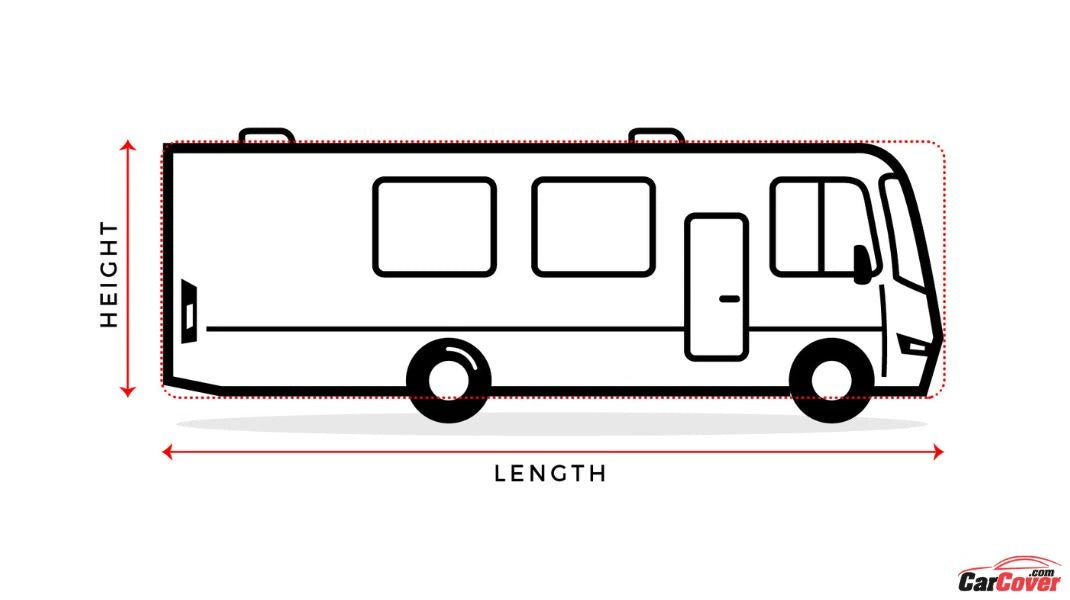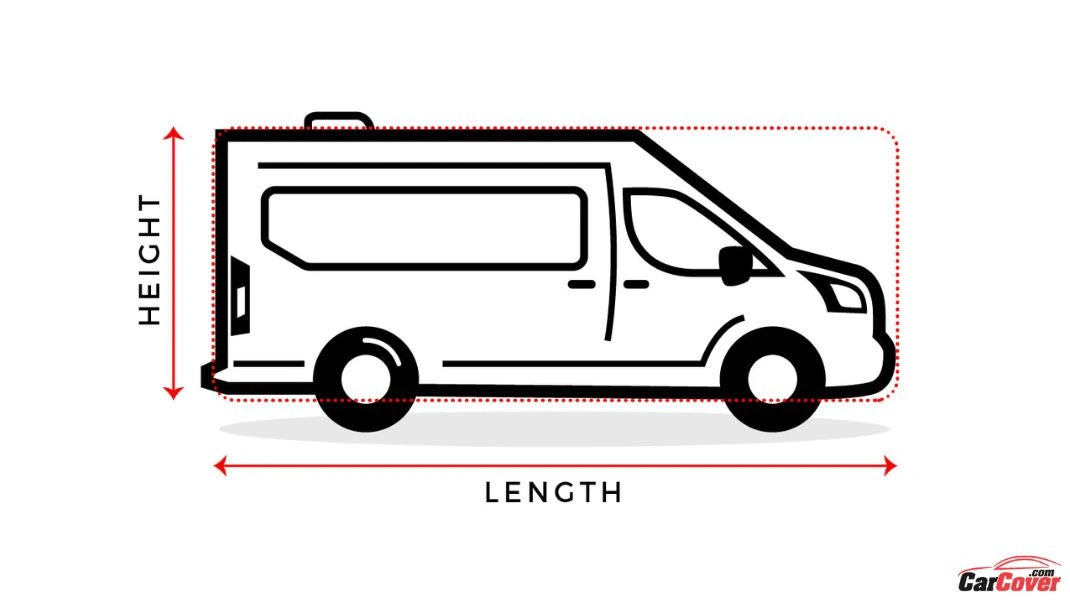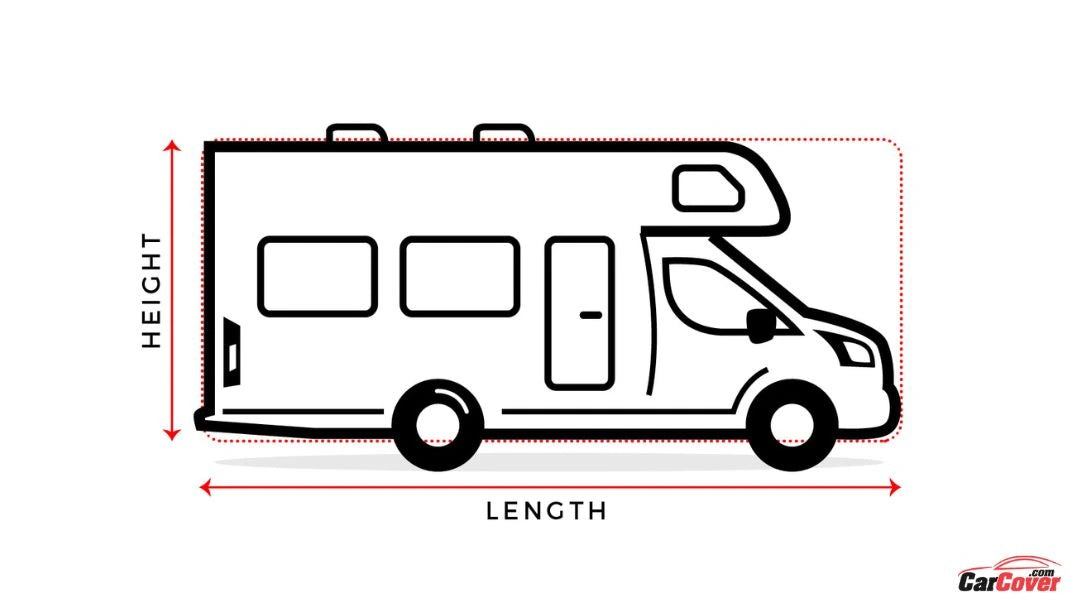
How to Properly Measure your RV for a Storage Cover
You've just purchased a new (or new to you) RV and want to make sure it stays in tip-top condition so that you can reap its many benefits for as long as possible. One way to protect your recreational vehicle, especially if you plan on storing it for any length of time, is by purchasing an RV storage cover.
Storage covers are great for preventing the accumulation of dirt, dust, sap and bird droppings on the surfaces of your RV, which can lead to damaging any exposed paint or finishes. Not only are storage covers water resistant, but they are also made with breathable fabric. This makes them perfect for damage protection against rain and snow, as well as reducing the amount of condensation and moisture between the cover and the RV's surfaces and accessories. While rain and snow are the most obvious threats, UV rays and wind can also cause damage to your RV.
Now that you know why it's important to purchase a cover and have decided to look for one, it is crucial to order the right size for the type of RV that you own. Anyone's first instinct would be to flip through the owner's manual and find the manufacturer's specifications for length, height and width. However, it is best to double-check these! We recommend that you take the measurements yourself because it is possible that there is a difference between the actual dimensions of the RV that you own and what the manual says its dimensions should be.
Properly measuring your RV helps you order a well-fitting cover the first time, which saves you from having to try and repack it so that you can return it for another size (what a hassle!!). But, more importantly, ordering a cover that is the right size for your recreational vehicle also ensures that it does what it is supposed to do, which is to provide as much protection as possible from the natural elements and other threats to its continued value.
Moreover, a properly fitting storage cover extends the lifetime of the cover itself. For instance, having a cover that is too small could result in an edge tearing through the fabric during installation or removal. Conversely, having a cover that is too big leads to billowing when the wind just won't let up and this causes the cover to rub against the surfaces of the RV, wearing down the cover's fabric over time. This means that you need an RV cover that fits as tightly as possible, but not too tightly, so that you get the most protection for both the RV and cover. Therefore, accurately measuring your recreational vehicle is a must before ordering a brand-new cover!
Here, we are discussing the kind of RV cover that secures with cinch ropes and straps, covering the entire body of the coach. Because these kinds of covers are designed with the specific type of recreational vehicle in mind (Fifth Wheel, Travel Trailer, Truck Camper, etc.), the height and width measurements are less important than length. The reason for this is that height and width measurements remain pretty consistent among each type of RV, so manufacturers produce covers that adhere to the dimensions common to each type. Just to be safe though, when measuring your RV, it is best to take down all three dimensions and double-check them against those of the covers on your wish list.
Below, you will first find general instructions for measuring each dimension: length, height, and width. You will then find a measurement guide accompanied by more specific tips for measuring the following categories of recreational vehicle: Class A, Class B, Class C, Fifth Wheel, Travel Trailer, Truck Camper, Folding Popup Camper, and TearDrop Camper
How to Measure Length, Height and Width
The standard system of measurement used by manufacturers and suppliers is always in feet and inches (n' n''):
| LENGTH | Taken by measuring the furthest two points from front to rear of RV. Always include bumpers, spare tire and ladder. Exclude trailer hitches and tongues. Propane tanks aren’t typically included but covers for these are available separately. |
|---|---|
| HEIGHT | Taken by measuring the RV sidewalls, from top of the roofline down to the outside frame. Do not stop at the top of the wheel well! Exclude any roof-mounted accessories, vents, A/C units, and ground clearance. |
| WIDTH | Stand facing the front of your RV, then measure from side to side at the widest point. Exclude mirrors and awnings. |
When you go to look at covers, they will be organized according to length ranges, for example, 28'1" – 31' or 31'1" – 34'. That said, the height and width dimensions can be located if you want to confirm these before ordering and paying for a cover.
NOTE:
- If your length measurement is at the higher end of the length range provided, there is no need to go up to the next biggest size. RV covers are made with extra fabric, which makes it easier to gather and fold the cover under when securing the cinch ropes and straps. It also ensures that longer RVs still have complete coverage. Covers are made a little bigger to also account for roof-mounted accessories, vents and air conditioning units. Going with the next size up could mean having a cover that is way too big!
- For example: If your RV measures 31', and the length ranges you have to choose between are 28'1" – 31' or 31'1" – 34', then order the smaller size cover (28'1" – 31'). But, if the length measurement of your RV is 31'1", then order the larger version of the cover (31'1" – 34').
How to Measure Each Type of RV, Trailer and Camper
Below you will find a measurement guide that provides a visual for where to measure the length and height according to each type of recreational vehicle. Following this guide, you will find specific tips for how to measure the length and height for each type of RV.
Class A
Length: Taken by measuring the furthest two points from front to rear of RV. Be sure to include bumpers, spare tire and ladder. For Class A motorhomes, measure to the bunk area or the very front of the bumper, whichever is furthest.
Height: Taken by measuring RV sidewalls from top of the roof down to the outside frame. Be sure to exclude ground clearance, A/C units, vents, and any roof-mounted accessories.

Class B
Length: Taken by measuring the furthest two points from front to rear of RV. Be sure to include bumpers, spare tire and ladder. For Class A motorhomes, measure to the bunk area or the very front of the bumper, whichever is furthest.
Height: Taken by measuring RV sidewalls from top of the roof down to the outside frame. Be sure to exclude ground clearance, A/C units, vents, and any roof-mounted accessories.
With Class B vans, include bubble height (measured from the very top of the van to the natural roofline of the van).

Class C
Length: Taken by measuring the furthest two points from front to rear of RV. Be sure to include bumpers, spare tire and ladder. For Class A motorhomes, measure to the bunk area or the very front of the bumper, whichever is furthest.
Height: Taken by measuring RV sidewalls from top of the roof down to the outside frame. Be sure to exclude ground clearance, A/C units, vents, and any roof-mounted accessories.

Fifth Wheel Trailer
Length: Taken by measuring the furthest two points from front to rear of trailer. For a fifth wheel, measure from the rear including bumper, spare tire and ladder, until the furthest point on the nose of the trailer coach. Always exclude the hitch and tongue.
Height: Taken by measuring trailer sidewalls from top of the roofline down to the outside frame. Never stopping at the top of the wheel well! Also exclude ground clearance, A/C units, vents, and any roof-mounted accessories.
Travel Trailer
Length: Taken by measuring the furthest two points from front to rear of trailer, including bumpers, spare tire, and ladder. Always exclude the hitch and tongue.
Height: Taken by measuring trailer sidewalls from top of the roofline to the outside frame, remembering not to stop at the top of wheel well. As always, exclude ground clearance, A/C units, vents, and any roof-mounted accessories.
Truck Camper
Length: Taken by measuring from the furthest two points of camper, including bumpers and ladder. For a camper with a rounded nose, measure from the furthest point forward on the nose.
Height: Taken by measuring camper sidewalls from top of the roofline to the outside frame. Exclude ground clearance, A/C units, vents, and any roof-mounted accessories.
If total length of you truck camper is under 216", you will need Truck Camper 8' to 10'
If total length of you truck camper is under 238", you will need Truck Camper 10' to 12'
Folding Popup Camper
Length: Taken by measuring the furthest two points from front to rear of camper, including the spare tire and ladder. Remember to exclude the hitch and tongue of the camper!
Height: Taken by measuring camper sidewalls from top of roofline to the outside frame. Exclude ground clearance, A/C units, vents, and any roof-mounted accessories. If there is an air conditioner, and your height measurement (excluding the A/C unit) is within 4 inches of the higher end of the length range given, we recommend that you choose the next size up.
TearDrop Camper
Length: Taken by measuring the furthest two points from front to rear of camper, including bumpers, spare tire, and ladder. With these campers, exclude the hitch and tongue.
Height: Taken by measuring camper sidewalls from top of the roofline to the outside frame, remembering not to stop at the top of wheel well. As always, exclude ground clearance, A/C units, vents, and any roof-mounted accessories.
Conclusion
With these instructions, you are now ready to properly measure your recreational vehicle, whichever type it may be! Once you have measured your RV, you can go ahead with choosing the appropriate length range for the measurements you took and placing an order for that brand-new storage rv cover.
This blog discussed why it is best to measure your RV before purchasing a storage cover, why it's important to have well-fitting cover, and how to measure your particular type of RV. Taking the measurements yourself leads to choosing the right size, which extends the lifetime of the cover by reducing wear and tear to its fabric (not to mention, it saves your valuable time and energy by not having to return it for another size!). A well-fitting cover also provides maximum damage protection from the natural elements and other threats to the continued value of your RV.
Frequently Asked Questions
1. Why should I measure my RV instead of using manufacturer specifications?
Manufacturer dimensions may not account for external accessories such as ladders or spare tires.
2. Should I size up if my RV falls on the border of two cover sizes?
No, most covers include extra fabric, so choose the smaller size if your RV falls on the border.
3. Can I use a generic tarp instead of an RV cover?
No, a generic tarp does not provide breathability, which can lead to moisture buildup and mold.
4. Will my cover protect against UV damage?
Yes, a high-quality RV cover will have UV-resistant properties.
5. How do I secure the cover properly?
Use cinch straps and tie-downs to prevent wind damage.
6. Can I install an RV cover alone?
It’s possible but easier with assistance, especially for larger RVs.
7. How long do RV covers last?
With proper care, an RV cover can last 3-5 years.
8. How should I clean my RV cover?
Use mild soap and water, and allow it to air dry.
9. Will an RV cover protect my vehicle in extreme weather?
Yes, but in high winds, extra tie-downs may be necessary.
10. Can I use an RV cover while camping?
Most covers are designed for storage, not for use during travel or active camping.









